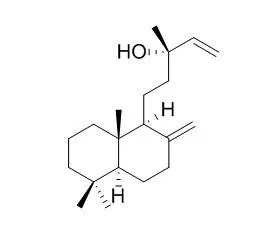| In vitro: |
| Chem Biodivers. 2007 Mar;4(3):531-8. | | Labdane diterpenoid glycosides from Aster veitchianus.[Pubmed: 17372956] |
METHODS AND RESULTS:
Four new labdane-type rhamnopyranosides derived from 13-Epimanool, compounds 1-4, with differently acetylated sugar moieties, were isolated from A. veitchianus. Their structures and absolute configurations were elucidated by chemical transformation, spectroscopic and mass-spectrometric analyses (IR, 1D- and 2D-NMR, HR-ESI-MS), as well as by single-crystal X-ray diffraction (compound 1).
CONCLUSIONS:
The isolates 2-4 were investigated for their cytotoxic properties against cultured human hepatoma (SMMC-7721), ovarian neoplasm (HO-8910), and leukemia (HL-60) cells, and for their antibacterial activities against Escherichia coli, Bacillus subtilis, and Staphylococcus aureus. | | J Agric Food Chem. 2012 Jan 11;60(1):124-8. | | Phytochemicals from Cunninghamia konishii Hayata act as antifungal agents.[Pubmed: 22129092 ] | The aims of the present study were to isolate and identify the antifungal compounds from the ethanolic extract of Cunninghamia konishii wood and to evaluate their antifungal activities against wood decay fungi.
METHODS AND RESULTS:
The results showed that the n-Hex soluble fraction of the ethanolic extract from C. konishii wood had an excellent inhibitory effect against Lenzites betulina, Trametes versicolor, Laetiporus sulphureus, and Gloeophyllum trabeum, with IC(50) values of 33, 46, 62, and 49 μg/mL, respectively. By following the bioactivity-guided fractionation procedure, four sesquiterpenes, T-cadinol, cedrol, T-muurolol, and (-)-epi-cedrol, and three diterpenes, 13-Epimanool, cis-abienol, and isoabienol, were identified from the active subfractions. Among the main constituents of the ethanolic extract from C. konishii, T-cadinol, cedrol, and T-muurolol efficiently inhibited the growth of four wood-rot fungi at the concentration of 100 μg/mL, with antifungal indices of 51.4-100.0%, 68.3-100.0%, and 39.5-100.0%, respectively.
CONCLUSIONS:
Results of this study show that the ethanolic extract of C. konishii wood may be considered as a potent source of T-cadinol, cedrol, and T-muurolol as new natural antifungal agents. |
|






 Cell. 2018 Jan 11;172(1-2):249-261.e12. doi: 10.1016/j.cell.2017.12.019.IF=36.216(2019)
Cell. 2018 Jan 11;172(1-2):249-261.e12. doi: 10.1016/j.cell.2017.12.019.IF=36.216(2019) Cell Metab. 2020 Mar 3;31(3):534-548.e5. doi: 10.1016/j.cmet.2020.01.002.IF=22.415(2019)
Cell Metab. 2020 Mar 3;31(3):534-548.e5. doi: 10.1016/j.cmet.2020.01.002.IF=22.415(2019) Mol Cell. 2017 Nov 16;68(4):673-685.e6. doi: 10.1016/j.molcel.2017.10.022.IF=14.548(2019)
Mol Cell. 2017 Nov 16;68(4):673-685.e6. doi: 10.1016/j.molcel.2017.10.022.IF=14.548(2019)